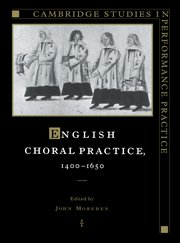Book contents
- Frontmatter
- Contents
- List of plates
- General preface
- Preface
- Abbreviations
- 1 To chorus from quartet: the performing resource for English church polyphony, c. 1390–1559
- 2 Editing and performing musica speculativa
- 3 The sound of Latin in England before and after the Reformation
- 4 English pronunciation, c. 1500 – c. 1625
- 5 Byrd, Tallis and Ferrabosco
- 6 John Baldwin and changing concepts of text underlay
- 7 Sacred songs in the chamber
- 8 The education of choristers in England during the sixteenth century
- 9 The ‘burden of proof’: the editor as detective
- Index of names and places
- Index of manuscript and printed music sources
- Index of works cited
8 - The education of choristers in England during the sixteenth century
Published online by Cambridge University Press: 03 March 2010
- Frontmatter
- Contents
- List of plates
- General preface
- Preface
- Abbreviations
- 1 To chorus from quartet: the performing resource for English church polyphony, c. 1390–1559
- 2 Editing and performing musica speculativa
- 3 The sound of Latin in England before and after the Reformation
- 4 English pronunciation, c. 1500 – c. 1625
- 5 Byrd, Tallis and Ferrabosco
- 6 John Baldwin and changing concepts of text underlay
- 7 Sacred songs in the chamber
- 8 The education of choristers in England during the sixteenth century
- 9 The ‘burden of proof’: the editor as detective
- Index of names and places
- Index of manuscript and printed music sources
- Index of works cited
Summary
The various aspects of the education of choristers during the first half of the sixteenth-century are well summarized in the statutes of St Pauls Cathedral:
Let him [the master of choristers] have eight boys of good character and respectable kindred, whom he should maintain and educate in moral training. And also let him see that they be instructed in song and writing, and that they be able to do all things appropriate to ministers of God in the choir.
The aim of choristers' education was not primarily musical; it was focused on the liturgy, the performance of which demonstrated practically the way to live a virtuous Christian life. In addition to musical skills, choristers learned to read and write English and Latin, and morals based on Christian teaching. This education prepared boys not only for musical careers, but also for many other careers, outside as well as inside the Church. Because of this, it was valuable, and choristers were not usually required to be poor as a prerequisite for admittance; Thomas Tusser, a choirboy at St Pauls under John Redford's care, was from a ‘gentle’ family.
The training was practical, rather than academic. Choristers learned by participating in many daily services (depending on the degree of solemnity): they read Scripture lessons, acted as crossbearers, censers, taperers and water bearers, and sang. Mostly, they sang chant, and even those choristers whose musical skills were at a basic level could take part. While beginners sang chant, the more experienced choristers improvised on it in a variety of ways ranging from simple to complex.
- Type
- Chapter
- Information
- English Choral Practice, 1400–1650 , pp. 180 - 199Publisher: Cambridge University PressPrint publication year: 1996
- 4
- Cited by

